Page 386 of 543
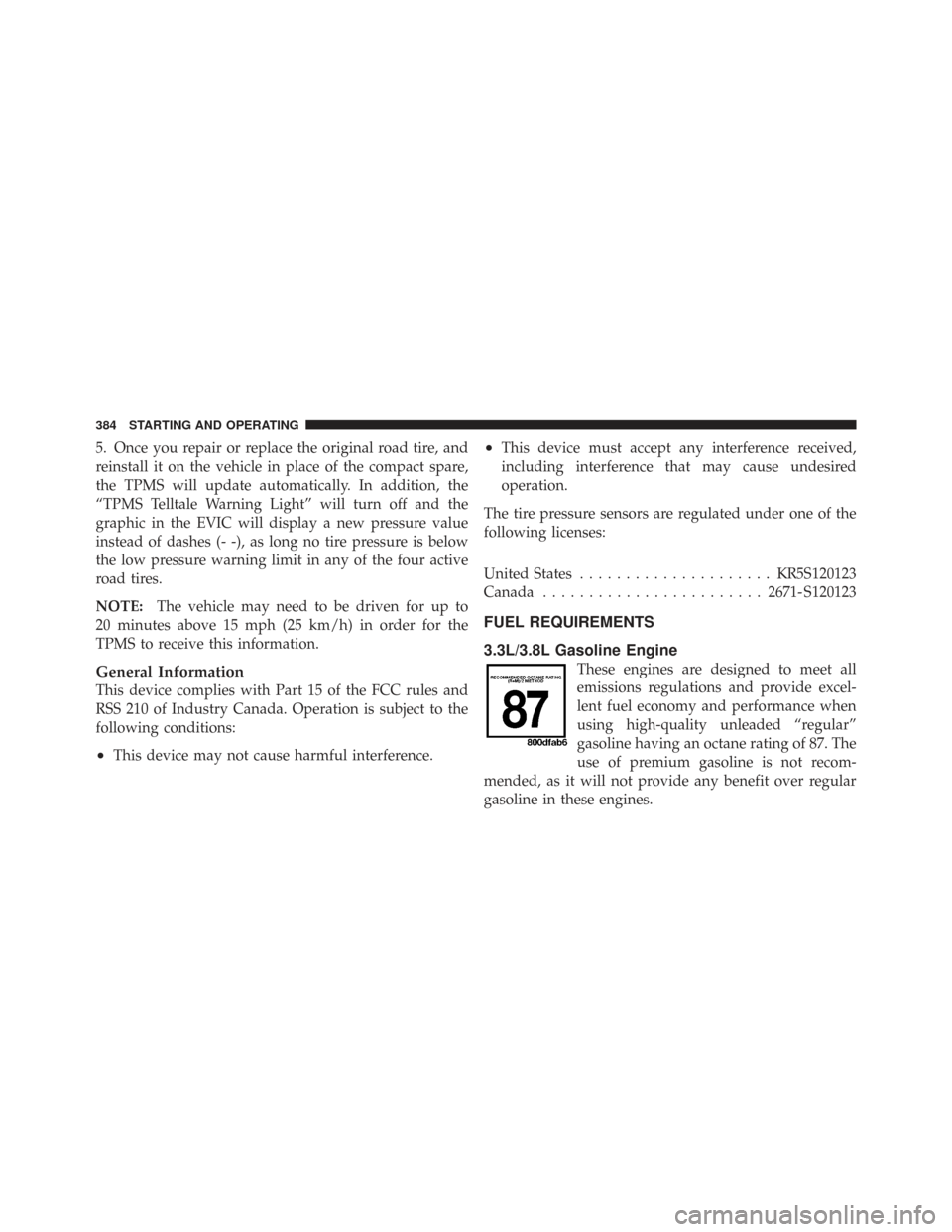
5. Once you repair or replace the original road tire, and
reinstall it on the vehicle in place of the compact spare,
the TPMS will update automatically. In addition, the
“TPMS Telltale Warning Light” will turn off and the
graphic in the EVIC will display a new pressure value
instead of dashes (- -), as long no tire pressure is below
the low pressure warning limit in any of the four active
road tires.
NOTE:The vehicle may need to be driven for up to
20 minutes above 15 mph (25 km/h) in order for the
TPMS to receive this information.
General Information
This device complies with Part 15 of the FCC rules and
RSS 210 of Industry Canada. Operation is subject to the
following conditions:
•This device may not cause harmful interference.
•This device must accept any interference received,
including interference that may cause undesired
operation.
The tire pressure sensors are regulated under one of the
following licenses:
United States ..................... KR5S120123
Canada ........................ 2671-S120123
FUEL REQUIREMENTS
3.3L/3.8L Gasoline Engine
These engines are designed to meet all
emissions regulations and provide excel-
lent fuel economy and performance when
using high-quality unleaded “regular”
gasoline having an octane rating of 87. The
use of premium gasoline is not recom-
mended, as it will not provide any benefit over regular
gasoline in these engines.
384 STARTING AND OPERATING
Page 398 of 543
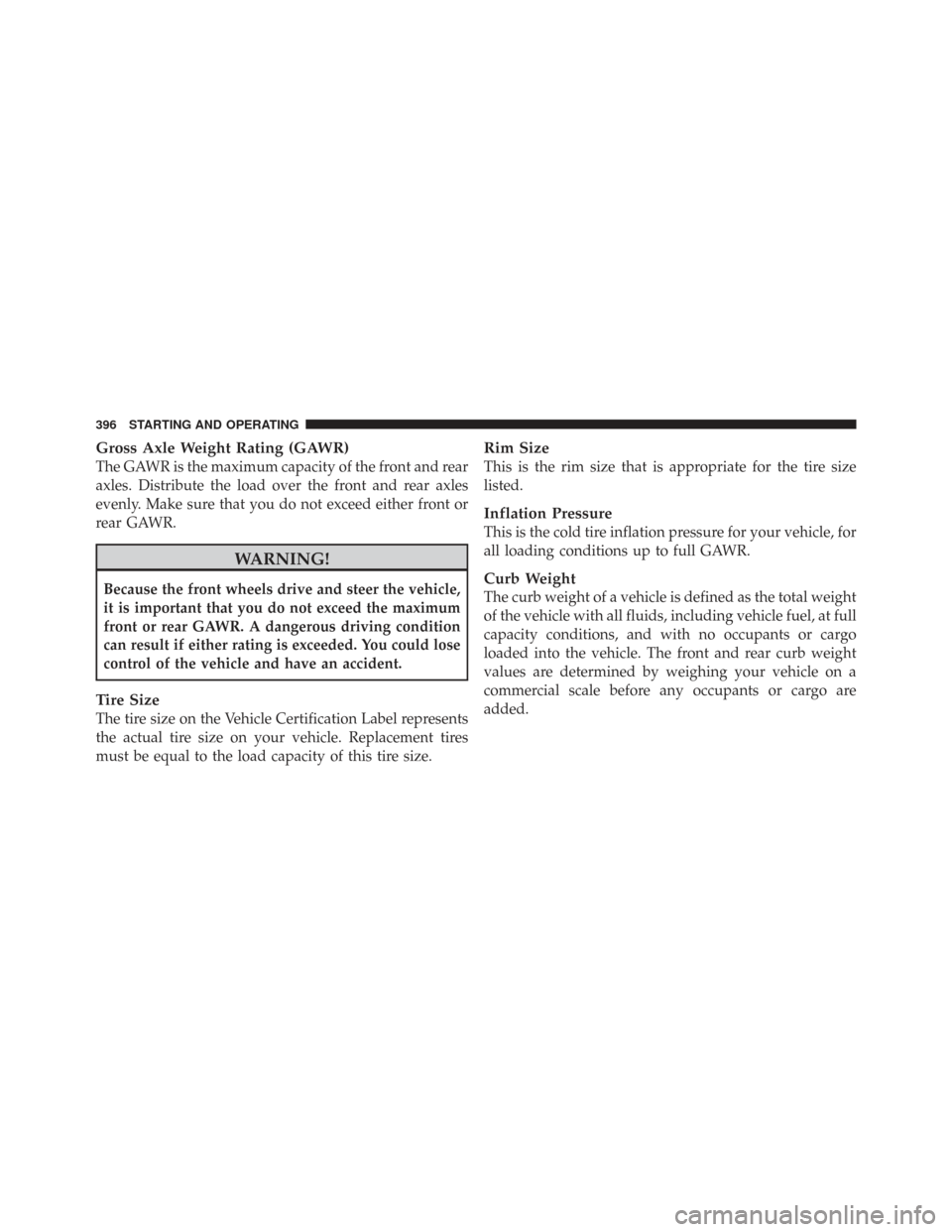
Gross Axle Weight Rating (GAWR)
The GAWR is the maximum capacity of the front and rear
axles. Distribute the load over the front and rear axles
evenly. Make sure that you do not exceed either front or
rear GAWR.
WARNING!
Because the front wheels drive and steer the vehicle,
it is important that you do not exceed the maximum
front or rear GAWR. A dangerous driving condition
can result if either rating is exceeded. You could lose
control of the vehicle and have an accident.
Tire Size
The tire size on the Vehicle Certification Label represents
the actual tire size on your vehicle. Replacement tires
must be equal to the load capacity of this tire size.
Rim Size
This is the rim size that is appropriate for the tire size
listed.
Inflation Pressure
This is the cold tire inflation pressure for your vehicle, for
all loading conditions up to full GAWR.
Curb Weight
The curb weight of a vehicle is defined as the total weight
of the vehicle with all fluids, including vehicle fuel, at full
capacity conditions, and with no occupants or cargo
loaded into the vehicle. The front and rear curb weight
values are determined by weighing your vehicle on a
commercial scale before any occupants or cargo are
added.
396 STARTING AND OPERATING
Page 410 of 543
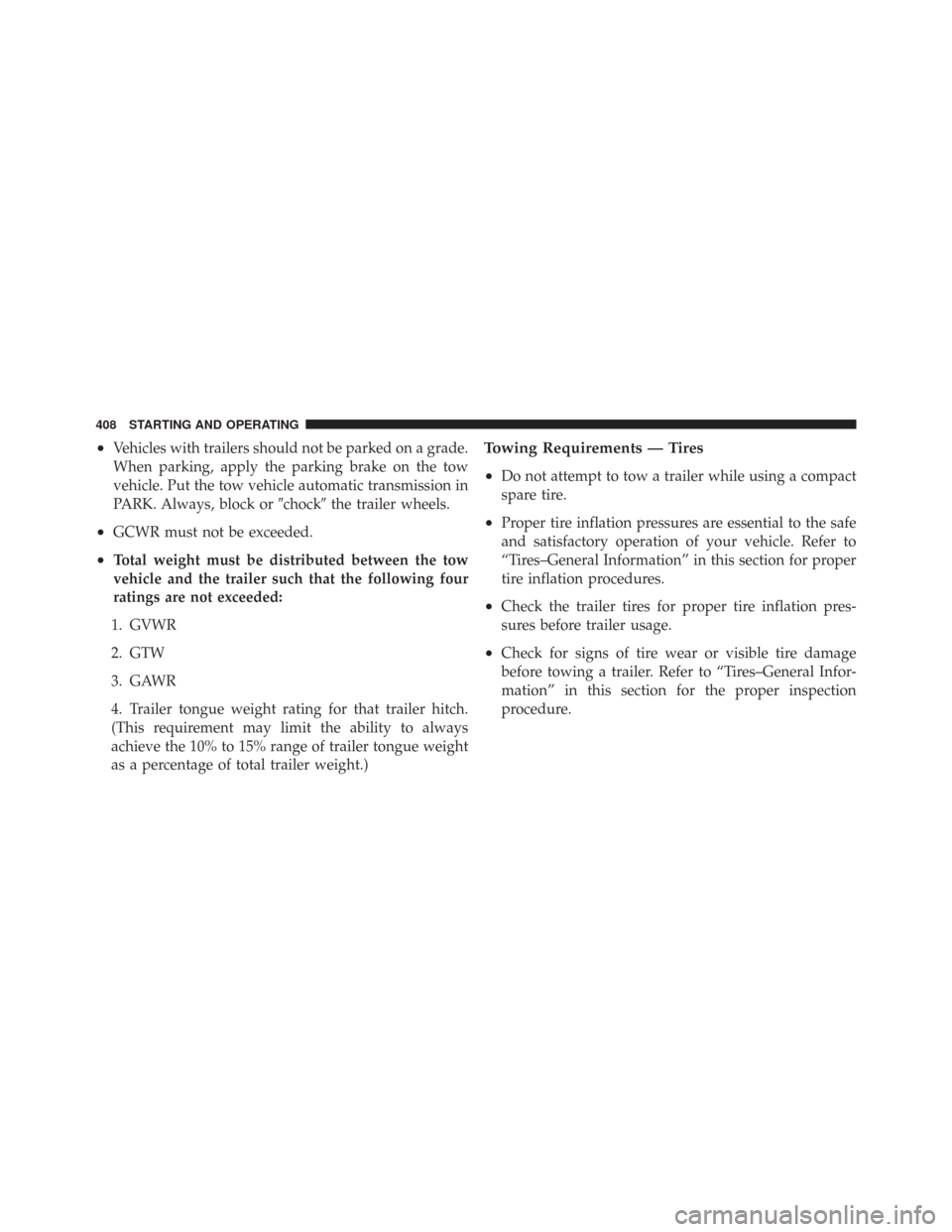
•Vehicles with trailers should not be parked on a grade.
When parking, apply the parking brake on the tow
vehicle. Put the tow vehicle automatic transmission in
PARK. Always, block or�chock�the trailer wheels.
•GCWR must not be exceeded.
•Total weight must be distributed between the tow
vehicle and the trailer such that the following four
ratings are not exceeded:
1. GVWR
2. GTW
3. GAWR
4. Trailer tongue weight rating for that trailer hitch.
(This requirement may limit the ability to always
achieve the 10% to 15% range of trailer tongue weight
as a percentage of total trailer weight.)
Towing Requirements — Tires
•
Do not attempt to tow a trailer while using a compact
spare tire.
•Proper tire inflation pressures are essential to the safe
and satisfactory operation of your vehicle. Refer to
“Tires–General Information” in this section for proper
tire inflation procedures.
•Check the trailer tires for proper tire inflation pres-
sures before trailer usage.
•Check for signs of tire wear or visible tire damage
before towing a trailer. Refer to “Tires–General Infor-
mation” in this section for the proper inspection
procedure.
408 STARTING AND OPERATING
Page 429 of 543
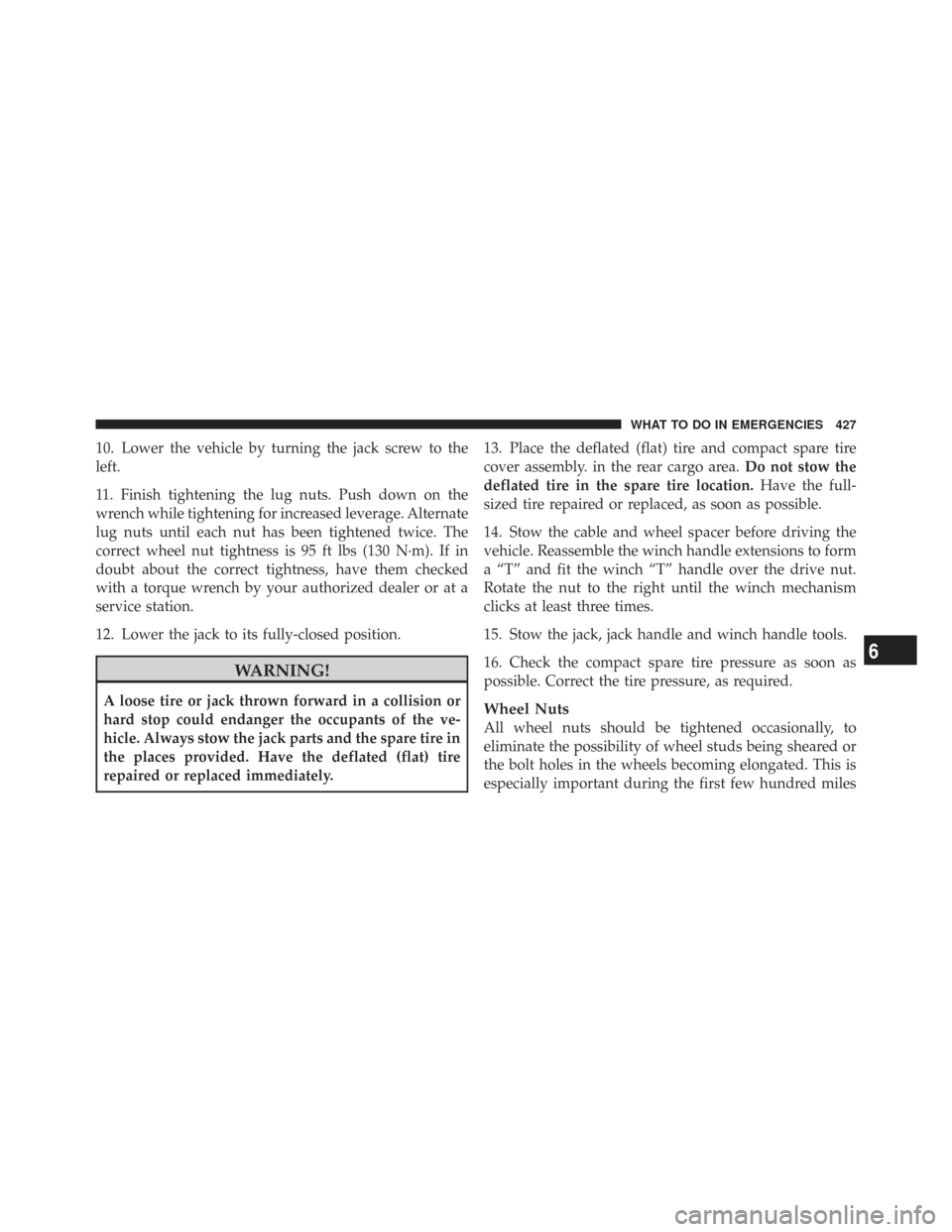
10. Lower the vehicle by turning the jack screw to the
left.
11. Finish tightening the lug nuts. Push down on the
wrench while tightening for increased leverage. Alternate
lug nuts until each nut has been tightened twice. The
correct wheel nut tightness is 95 ft lbs (130 N·m). If in
doubt about the correct tightness, have them checked
with a torque wrench by your authorized dealer or at a
service station.
12. Lower the jack to its fully-closed position.
WARNING!
A loose tire or jack thrown forward in a collision or
hard stop could endanger the occupants of the ve-
hicle. Always stow the jack parts and the spare tire in
the places provided. Have the deflated (flat) tire
repaired or replaced immediately.13. Place the deflated (flat) tire and compact spare tire
cover assembly. in the rear cargo area.
Do not stow the
deflated tire in the spare tire location. Have the full-
sized tire repaired or replaced, as soon as possible.
14. Stow the cable and wheel spacer before driving the
vehicle. Reassemble the winch handle extensions to form
a “T” and fit the winch “T” handle over the drive nut.
Rotate the nut to the right until the winch mechanism
clicks at least three times.
15. Stow the jack, jack handle and winch handle tools.
16. Check the compact spare tire pressure as soon as
possible. Correct the tire pressure, as required.Wheel Nuts
All wheel nuts should be tightened occasionally, to
eliminate the possibility of wheel studs being sheared or
the bolt holes in the wheels becoming elongated. This is
especially important during the first few hundred miles
6
WHAT TO DO IN EMERGENCIES 427
Page 459 of 543
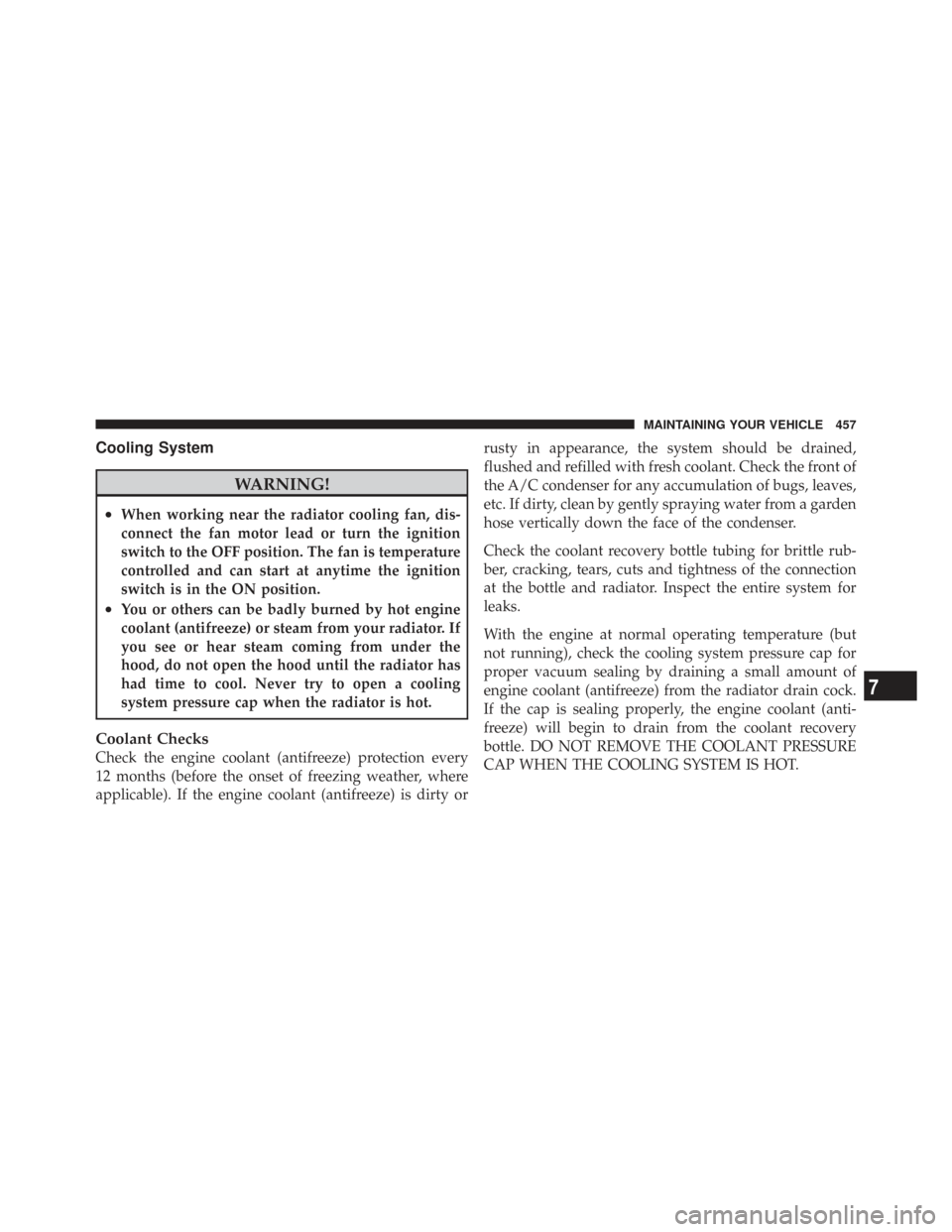
Cooling System
WARNING!
•When working near the radiator cooling fan, dis-
connect the fan motor lead or turn the ignition
switch to the OFF position. The fan is temperature
controlled and can start at anytime the ignition
switch is in the ON position.
•You or others can be badly burned by hot engine
coolant (antifreeze) or steam from your radiator. If
you see or hear steam coming from under the
hood, do not open the hood until the radiator has
had time to cool. Never try to open a cooling
system pressure cap when the radiator is hot.
Coolant Checks
Check the engine coolant (antifreeze) protection every
12 months (before the onset of freezing weather, where
applicable). If the engine coolant (antifreeze) is dirty orrusty in appearance, the system should be drained,
flushed and refilled with fresh coolant. Check the front of
the A/C condenser for any accumulation of bugs, leaves,
etc. If dirty, clean by gently spraying water from a garden
hose vertically down the face of the condenser.
Check the coolant recovery bottle tubing for brittle rub-
ber, cracking, tears, cuts and tightness of the connection
at the bottle and radiator. Inspect the entire system for
leaks.
With the engine at normal operating temperature (but
not running), check the cooling system pressure cap for
proper vacuum sealing by draining a small amount of
engine coolant (antifreeze) from the radiator drain cock.
If the cap is sealing properly, the engine coolant (anti-
freeze) will begin to drain from the coolant recovery
bottle. DO NOT REMOVE THE COOLANT PRESSURE
CAP WHEN THE COOLING SYSTEM IS HOT.
7
MAINTAINING YOUR VEHICLE 457
Page 480 of 543
FUSES/TIPM
Cavity Cartridge
Fuse Mini-
Fuse Description
M15 — 20 Amp YellowRear View Mirror
(RR VW MIR),
Cabin Compart-
ment Node (CCN),
Multi-Function
Control Switch
(MULTIFTCN SW),
Tire Pressure Moni-
tor (TPM), Glow
Plug Module (GLW
PLG MOD) — Ex-
port Diesel Only,
Assy-Shifter (Hall
Effect), Acoustic
Noise Cancellation
(ANC)FUSES/TIPM
Cavity Cartridge
Fuse Mini-
Fuse Description
M16 — 10 Amp RedOccupant Restraint
Controller/
Occupant Classifi-
cation Module
(ORC/OCM)
M17 — 15 Amp BlueLeft Tail/License/
Park Lamp (LT-
TAIL/LIC/PRK
LMP), Running
Lamps
M18 — 15 Amp BlueRight Tail/Park/
Run Lamp (RT-
TAIL/PRK/RUN
LMP)
M19 — 25 Amp NaturalAuto Shut Down
(ASD #1 and #2)
478 MAINTAINING YOUR VEHICLE
Page 495 of 543
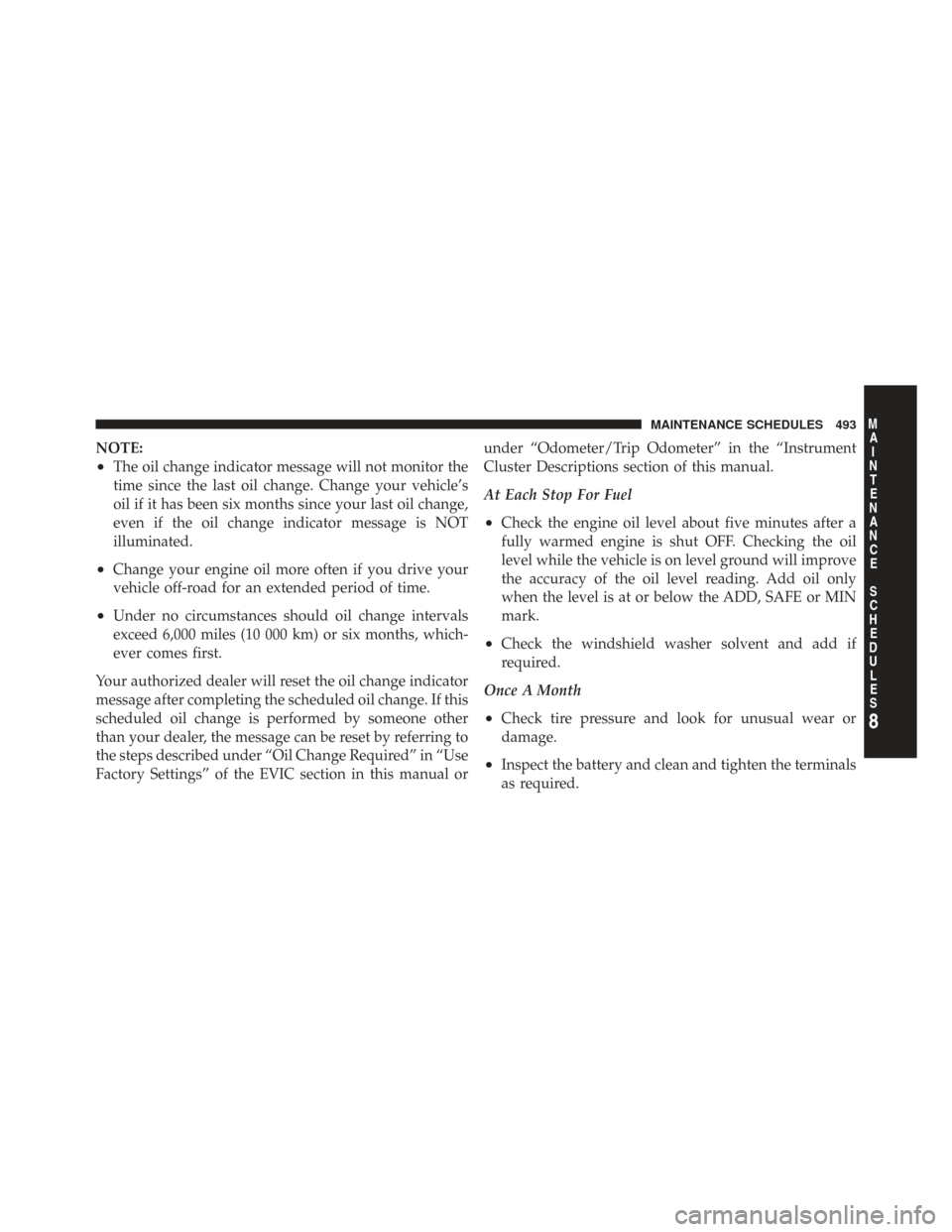
NOTE:
•The oil change indicator message will not monitor the
time since the last oil change. Change your vehicle’s
oil if it has been six months since your last oil change,
even if the oil change indicator message is NOT
illuminated.
•Change your engine oil more often if you drive your
vehicle off-road for an extended period of time.
•Under no circumstances should oil change intervals
exceed 6,000 miles (10 000 km) or six months, which-
ever comes first.
Your authorized dealer will reset the oil change indicator
message after completing the scheduled oil change. If this
scheduled oil change is performed by someone other
than your dealer, the message can be reset by referring to
the steps described under “Oil Change Required” in “Use
Factory Settings” of the EVIC section in this manual or under “Odometer/Trip Odometer” in the “Instrument
Cluster Descriptions section of this manual.
At Each Stop For Fuel
•Check the engine oil level about five minutes after a
fully warmed engine is shut OFF. Checking the oil
level while the vehicle is on level ground will improve
the accuracy of the oil level reading. Add oil only
when the level is at or below the ADD, SAFE or MIN
mark.
•Check the windshield washer solvent and add if
required.
Once A Month
•Check tire pressure and look for unusual wear or
damage.
•Inspect the battery and clean and tighten the terminals
as required.
8
M A I
N T
E
N A
N CE
S
C
H E
D
U L
E
SMAINTENANCE SCHEDULES 493
Page 522 of 543
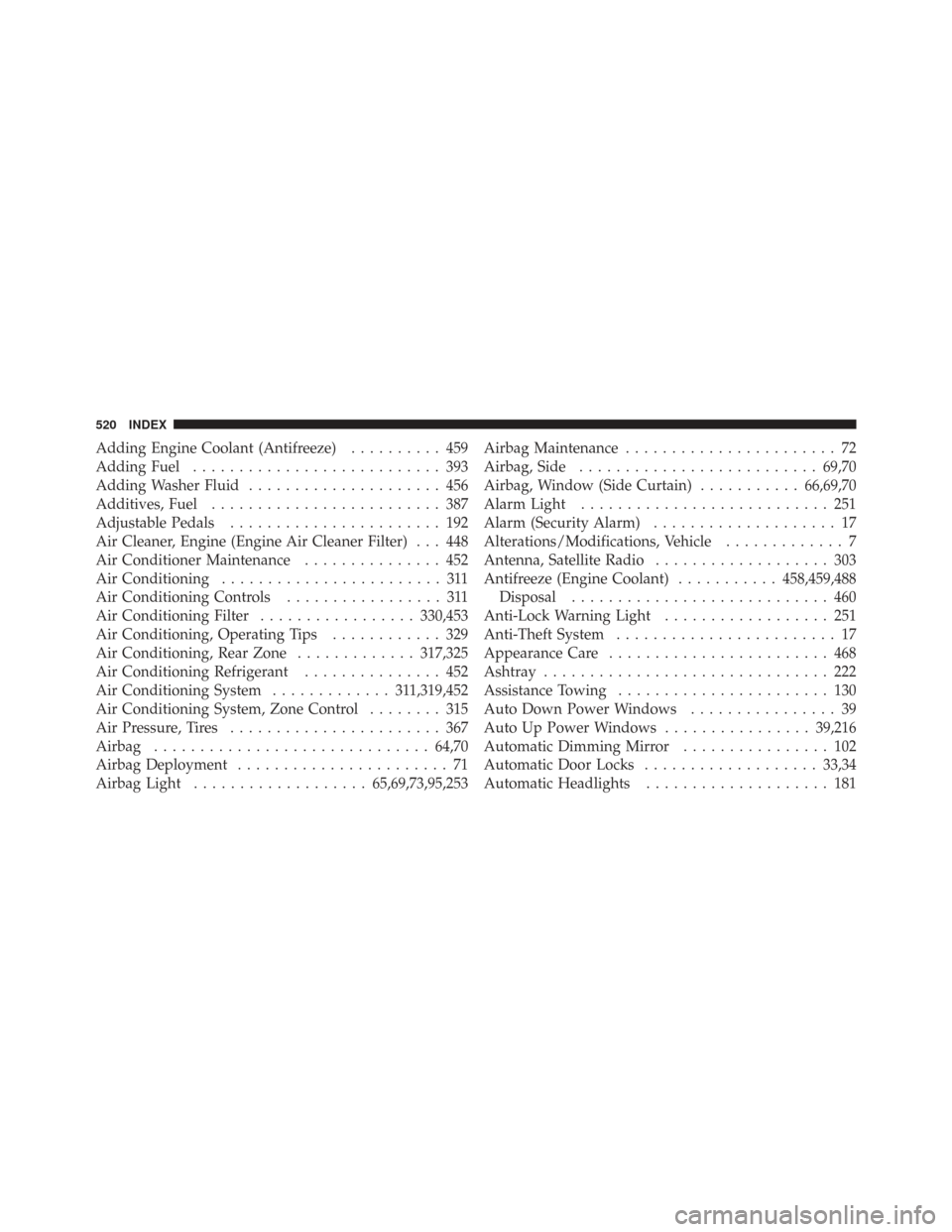
Adding Engine Coolant (Antifreeze).......... 459
Adding Fuel ........................... 393
Adding Washer Fluid ..................... 456
Additives, Fuel ......................... 387
Adjustable Pedals ....................... 192
Air Cleaner, Engine (Engine Air Cleaner Filter) . . . 448
Air Conditioner Maintenance ............... 452
Air Conditioning ........................ 311
Air Conditioning Controls ................. 311
Air Conditioning Filter .................330,453
Air Conditioning, Operating Tips ............ 329
Air Conditioning, Rear Zone .............317,325
Air Conditioning Refrigerant ............... 452
Air Conditioning System ............. 311,319,452
Air Conditioning System, Zone Control ........ 315
Air Pressure, Tires ....................... 367
Airbag .............................. 64,70
Airbag Deployment ....................... 71
Airbag Light ................... 65,69,73,95,253Airbag Maintenance
....................... 72
Airbag, Side .......................... 69,70
Airbag, Window (Side Curtain) ...........66,69,70
Alarm Light ........................... 251
Alarm (Security Alarm) .................... 17
Alterations/Modifications, Vehicle ............. 7
Antenna, Satellite Radio ................... 303
Antifreeze (Engine Coolant) ...........458,459,488
Disposal ............................ 460
Anti-Lock Warning Light .................. 251
Anti-Theft System ........................ 17
Appearance Care ........................ 468
Ashtray ............................... 222
Assistance Towing ....................... 130
Auto Down Power Windows ................ 39
Auto Up Power Windows ................39,216
Automatic Dimming Mirror ................ 102
Automatic Door Locks ................... 33,34
Automatic Headlights .................... 181
520 INDEX